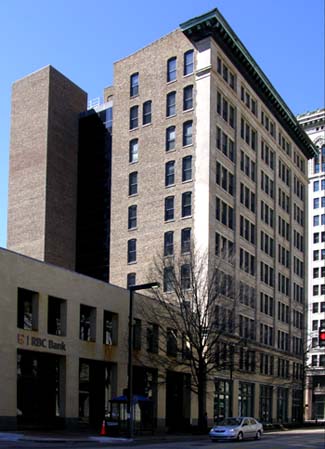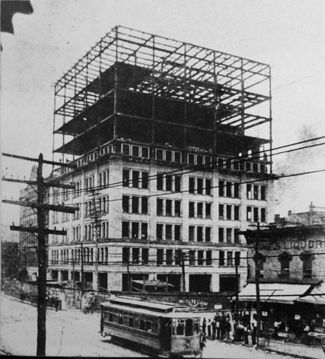Woodward Building
The Woodward Building is a 10-story, 132 foot tall Chicago-style office tower built on the southwest corner of 20th Street and 1st Avenue North in 1902. The building was financed by William Woodward from the proceeds of his sale of Woodward Iron Company, and was one of the earlier designs of architect William Weston, who collaborated with the Stone Brothers, Architects of New Orleans, Louisiana on the design. It was the first steel-framed building erected in Birmingham. As such, the general contractor, Ino Griffiths and Son, was brought down from Chicago, Illinois. The cost of construction was $350,000.
No building yet built in Birmingham was nearly so large or tall, and serious doubts were raised about the ability of the local office market to absorb the added space. The criticisms recalled those that followed the erection of Linn's Folly on the opposite corner 30 years earlier. Nevertheless, the Woodward Building was fully leased at completion and was eagerly followed within a few years by several larger office towers, including three others at the same intersection.
The Woodward Building features a light brown brick façade divided into triple window bays by tall pilasters. The deep cornice is an elaborately-detailed metal construction of the type common in commercial architecture of the time. The interior was finished with tile and marble wainscot in the corridors, oak paneling in the offices, and a monumental wrought-iron and marble stair.
By the time the American Trust and Savings Bank Building was completed in 1912, the four skyscrapers at 20th Street and 1st Avenue were being billed as the "Heaviest Corner in the South." Over the years, that claim was inflated to the improbable "Heaviest Corner on Earth", which remains a popular name for the grouping.
In the 1930s the lower floors were re-clad with dark-green and black polished granite.
On July 29, 1950, shortly after the Birmingham City Commission made membership in the Communist Party a misdemeanor punishable by jail time, a man named George Breland, of New York City, dropped hundreds of leaflets from the window of a 10th floor bathroom onto the street below. The leaflets, printed by the Alabama Communist Party, referred to unsolved bombings in Birmingham, urged readers to support India's offer to arbitrate the Korean conflict, and endorsed China's application to join the United Nations.
In 1983 the Woodward Building was added to the National Register of Historic Places. In 1985 Doster Construction completed an interior and exterior renovation designed by Kidd, Plosser and Sprague. The new work included a restoration of the first and second levels and the addition of an enclosed parking garage and a two-story curtain-walled extension toward Morris Avenue.
The building presently houses Ligon Industries and the Birmingham offices of PNC Bank.
Tenants
- Ground floor:
- 2nd floor:
- 201: Anthony Malavazos physician (1926), Alabama Optical Supply Co. (1940)
- 203–204: John E. Garrison physician (1926–1940)
- 205–206: Francis B. Latady & Co. accountants (1940)
- 207: American District Telegraph Co. (1926)
- 209-210: Roberts Johnson & Rand shoe manufacturers (1926–1940)
- 211: H. B. Whiteside physician (1926)
- 211–215: Morrow Watkins & Co. investments (1940)
- 211-212: Main & Company loans (1934)
- 214: The Broadstreet Co. (1926)
- 218-219: Maryland Casualty Co. (1926), Green-Darden Real Estate & Insurance Co. (1940)
- 220–221: Birmingham Finance Service (1940)
- 220: J. T. Coulborn / H. P. Levy physicians (1926)
- 222–224: General Loan Service Inc. (1940)
- 222-223: Guardian Life Insurance Co. (1926)
- 225: Woodward Stenographic Bureau (1926), Railway Mail Credit Union / Jackson Morrow food broker / Myatt-Benton Brokerage Co. (1940)
- 226: Wilson Jewelry Co. repairs (1940)
- 227: John C. Crouch Co. livestock (1940)
- 3rd floor:
- 301–304: Barker Insurance Agency / United Electric Co. (1940)
- 303: DuBois & McCrossin (1909)
- 305–306: Edgar Daly physician (1940)
- 309-311: Jerome Meyer / H. R. Carter Jr (1926), Jesse Waites dentist (1940)
- 314-317: Estes Real Estate & Insurance Co. (1926)
- 314–315: Alabama Securities Corp. (1940)
- 317–319: Dixie Finance Co. loans (1940)
- 318-319: W. S. Sewell physician (1926)
- 320–321: Curran Williams & Issos Demetrius dentists / William Prescott Jr physician (1940)
- 322–324: Anthony Vafes dentist (1940)
- 325: W. Nicholson Jones physician (1940)
- 326: The Brick Exchange (1926)
- 301–304: Barker Insurance Agency / United Electric Co. (1940)
- 4th floor:
- 403: Electropoise Co./McCrossin Whole Grain Wheat Co./Beard Artz-McCrossin Coal Co. (1926)
- 405-408: Southern Pacific Lines (1926)
- 407–408: Jules Gelperin physician (1940)
- 407: W. C. Weston architect (1904), Personal Finance Co. (1934)
- 407–408: Jules Gelperin physician (1940)
- 409–410: Robert McGahey physician (1940)
- 411–417: Union Central Life Insurance Co. (1926)
- 414–415: Employees Finance Co. loans (1940)
- 416-417: John Newman osteopath (1940)
- 418–419: Doctors Bureau Inc. collections (1940)
- 420–421: Diamond Jewelry Co. wholesale (1940)
- 422–424: Farley Harris physician (1940)
- 425–429: W. Chunn Parsons physician (1940)
- 425: J. C. Turner architect (1904)
- 5th floor:
- 501–506: Richard Woodson physician (1940)
- 507–508: Willis Massey dentist (1940)
- 509–510: J. L. Willingham Co./Webb Realty Co./J. M. Hicks (1926)
- 511–512: Samuel Applebaum / Arthur W. Woods physicians (1940)
- 511: Moses Ullman attorney (1907)
- 513–518: R. G. Dun & Co. (1926)
- 514–516: Herbert Harris physician (1940)
- 517: William G. White dentist (1940)
- 518–519: Marion Tissier dentist (1940)
- 520–524: Birmingham Compress Corp./Howel Cotton Company of Birmingham (1926)
- 520–521: Leahmon McGinnis dentist (1940)
- 6th floor:
- 601–607: Arthurt J. Ribe traffic bureau (1940)
- 601–604: [Morgan-Hill Paving Co.]] (1926)
- 605–607: Kershaw Mining Co. / C. G. Kershaw Contracting Co. (1926)
- 608–610: Herbert Green dentist (1940)
- 611–612: Loran Calhoun dentist (1940)
- 614–617: Leroy Kincannon dentist (1940)
- 614: Seaboard Air Line Railroad (1926)
- 618–619: Oliver Stewart dentist (1940)
- 620–624: Acacia Mutual Life Insurance Co. / Coke Wright insurance agent
- 620: Isthmian Coal & Trading Co./Warrior View Coal Co./Borden Coal Co. (1926)
- 622: Electric Blue Printing Co. (1926)
- 625–626: Travis McGahey physician (1940)
- 601–607: Arthurt J. Ribe traffic bureau (1940)
- 7th floor:
- 701-729: Republic Iron & Steel Co. (1926)
- 701–710: Industrial Life & Health Insurance Co. (1940)
- 725–729: Cecil Gaines physician (1940)
- 701-729: Republic Iron & Steel Co. (1926)
- 8th floor:
- 801–808: A. J. Ribe/Lumbermen's Traffic Association (1926)
- 810: Retail Credit Co. (1926)
- 811–812: Robert Berry physician (1940)
- 814–815: James A. Livingston physician (1940)
- 814: St Louis & San Francisco Railroad (1926)
- 818–820: Huey Green / Paul W. Shannon physicians (1940)
- 823–824: Isthmian Coal & Trading Co. / Dixie Fire Brick Co. (1930–1961)
- 825–829: Ollie Board / Daniel Coyle physicians (1940)
- 9th floor:
- 901: Louise Branscomb physician (1940)
- 903–904: Shephard Electric Crane & Hoist Co. / R. B. Clarke & Co. (1926), Lide & Adler consulting engineers (1940)
- 905–906: New York Central Lines (1926)
- 905: Edgar Adler (1940)
- 907–908: Kellie Joseph physician (1940)
- 909–910: Gilbert Greene physician (1940)
- 914: Robert McGavock / William R. Gunn dentists (1940)
- 915–916: Leo Dillon dentist (1940)
- 919: Luther Wilson physician (1940)
- 923–924: International Correspondence School (1926–1940)
- 925–928: Edmund Rucker Jr physician (1940)
- 925–926: Rucker & Staggers physicians (1926)
- 930: Iron Clad Hosiery Mill (1926)
- 10th floor:
- 1001–1004: Abner Atwood physician (1940)
- 1005–1007: Missouri Pacific Lines general agent (1940)
- 1007–1010: Missouri Pacific Lines (1926)
- 1014–1015: P. S. Mewhinney, architect (1926), Salie & Mewhinney, architects
- 1015: H. H. Robertson Co. building supplies (1940)
- 1016–1019: Clarence Wiley physician (1940)
- 1020–1021: Texas & Pacific Railway Co. (1926), Physicians Credit Bureau collections / Medical Acceptance Corp. financing (1940)
- 1025–1029: Birmingham Clay Products Co./Rust Engineering (1926)
- 1025–1026: Marye Dabney physician (1940)
- former location of PNC Bank (-2019)
- Ligon Industries
- First Avenue Ventures (Michael Goodrich)
- Total on 1st medical aesthetic spa (2021–)
- RBC Bank (–2012), PNC Bank (2012–2020)
References
- "Birmingham's reds drop leaflets off 12-story building." (July 30, 1950) Sunday Star-News (Wilmington, North Carolina)
- White, Marjorie Longenecker, ed. (1977) Downtown Birmingham: Architectural and Historical Walking Tour Guide. Birmingham:Birmingham Historical Society.
- Satterfield, Carolyn Green (1986) Historic Sites of Jefferson County, Alabama. Revised edition. Birmingham: Jefferson County Historical Commission/Gray Printing Company
- Jefferson County Historical Commission. (1998) Birmingham and Jefferson County, Alabama Images of America Series. Charleston, SC: Arcadia Publishing. ISBN0752413465


